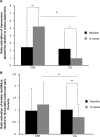Effect of 10-week core stabilization exercise training and detraining on pain-related outcomes in patients with clinical lumbar instability
- PMID: 24399870
- PMCID: PMC3875242
- DOI: 10.2147/PPA.S50436
Effect of 10-week core stabilization exercise training and detraining on pain-related outcomes in patients with clinical lumbar instability
Abstract
Background and aims: Clinical lumbar instability causes pain and socioeconomic suffering; however, an appropriate treatment for this condition is unknown. This article examines the effect of a 10 week core stabilization exercise (CSE) program and 3 month follow-up on pain-related outcomes in patients with clinical lumbar instability.
Methods: Forty-two participants with clinical lumbar instability of at least 3 months in duration were randomly allocated either to 10 weekly treatments with CSE or to a conventional group (CG) receiving trunk stretching exercises and hot pack. Pain-related outcomes including pain intensity during instability catch sign, functional disability, patient satisfaction, and health-related quality of life were measured at 10 weeks of intervention and 1 and 3 months after the last intervention session (follow-up); trunk muscle activation patterns measured by surface electromyography were measured at 10 weeks.
Results: CSE showed significantly greater reductions in all pain-related outcomes after 10 weeks and over the course of 3 month follow-up periods than those seen in the CG (P<0.01). Furthermore, CSE enhanced deep abdominal muscle activation better than in the CG (P<0.001), whereas the CG had deterioration of deep back muscle activation compared with the CSE group (P<0.01). For within-group comparison, CSE provided significant improvements in all pain-related outcomes over follow-up (P<0.01), whereas the CG demonstrated reduction in pain intensity during instability catch sign only at 10 weeks (P<0.01). In addition, CSE showed an improvement in deep abdominal muscle activation (P<0.01), whereas the CG revealed the deterioration of deep abdominal and back muscle activations (P<0.05).
Conclusion: Ten week CSE provides greater training and retention effects on pain-related outcomes and induced activation of deep abdominal muscles in patients with clinical lumbar instability compared with conventional treatment.
Keywords: clinical lumbar instability; core stabilization exercise; detraining effect; quality of life; trunk muscle activation.
Figures



References
-
- Silfies SP, Squillante D, Maurer P, Westcott S, Karduna AR. Trunk muscle recruitment patterns in specific chronic low back pain populations. Clin Biomech (Bristol, Avon) 2005;20(5):465–473. - PubMed
-
- White AA, Panjabi MM. Clinical Biomechanics of the Spine. Philadelphia, PA: Lippincott-Raven; 1990.
-
- Javadian Y, Behtash H, Akbari M, Taghipour-Darzi M, Zekavat H. The effects of stabilizing exercises on pain and disability of patients with lumbar segmental instability. J Back Musculoskelet Rehabil. 2012;25(3):149–155. - PubMed
-
- Kotilainen E, Valtonen S. Clinical instability of the lumbar spine after microdiscectomy. Acta Neurochir (Wien) 1993;125(1–4):120–126. - PubMed
-
- Panjabi MM. The stabilizing system of the spine. Part I. Function, dysfunction, adaptation, and enhancement. J Spinal Disord. 1992;5(4):383–389. - PubMed
LinkOut - more resources
Full Text Sources
Other Literature Sources
Medical

